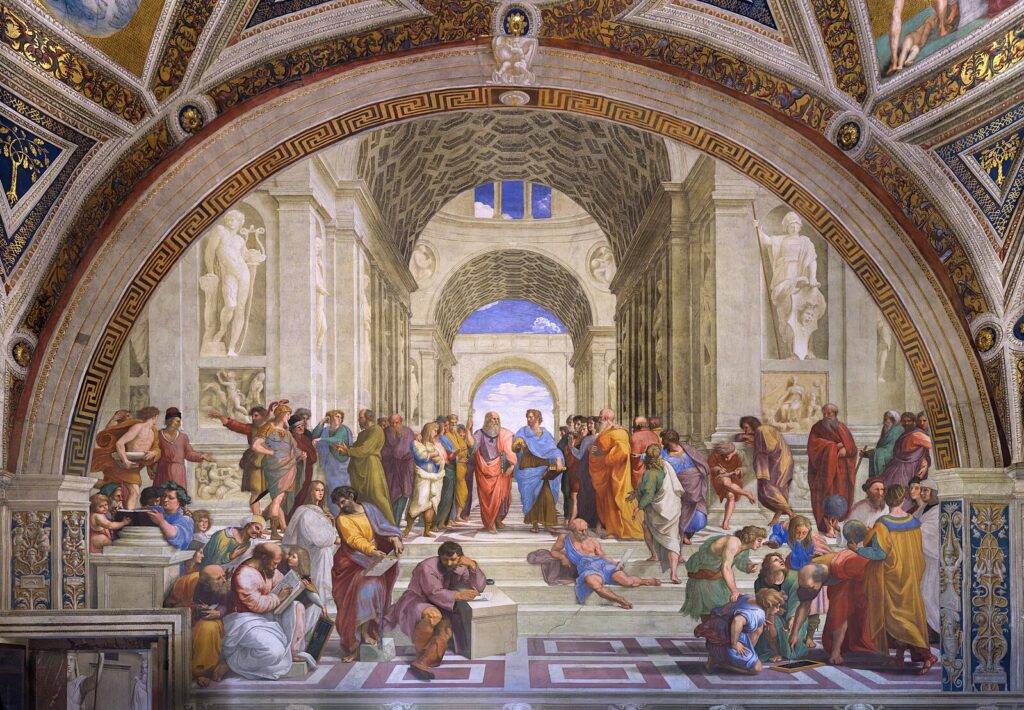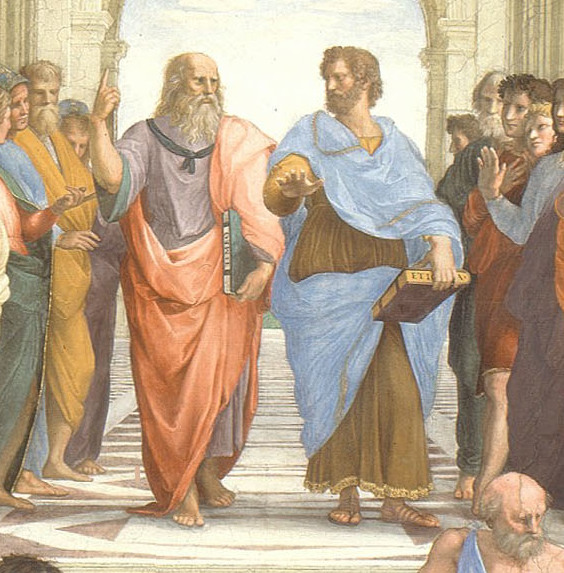In the pantheon of art history, few works encapsulate the triumph of human achievement quite like Raphael’s “The School of Athens.” This iconic fresco, covering the walls of the Vatican’s Apostolic Palace, is not merely a masterpiece of Renaissance artistry.
The various murals on the walls represent the fields at the heart of humanist studies. It is a key piece of Renaissance art.
It captures the spirit of the intellectual movement and depicts numerous philosophers and artists who have contributed to human history and thought. Scholars still investigate the art piece today, unraveling its rich symbolism, intricate composition, and enduring legacy.

Context and Commission
“The School of Athens” was painted by the Italian Renaissance master Raphael between 1509 and 1511, during the height of the High Renaissance. It was commissioned by Pope Julius II as part of a series of frescoes for the papal apartments.
The painting is one of three intended to adorn the Stanza della Segnatura, the pope’s private library, and serve as a celebration of humanistic learning and intellectual inquiry. Together the paintings represent theology, literature, and philosophy and depict some of the most famous characters in each field.
Socrates, Plato, and Archimedes are all featured, as well as references to other Renaissance artists Leonardo Da Vinci and Michelangelo.
Composition and Setting
Set against a grand backdrop reminiscent of a classical Roman basilica, “The School of Athens” features a gathering of some of history’s greatest philosophers, mathematicians, and thinkers. It invokes the classic image of the agora, or public venue of debate.
The central figures of the composition are Plato and Aristotle. They are depicted as walking through the halls of learning, unveiling new knowledge together.
Surrounding Plato and Aristotle are a host of other famous Greek philosophers, mathematicians, and other thinkers. Each are engaged in discussion, debate, or contemplation.
From Pythagoras and Euclid to Socrates and Diogenes, the fresco is a veritable who’s who of ancient philosophy, with figures from different schools of thought converging in a harmonious symphony of intellect and wisdom.
Nearly every great Greek philosopher is represented, but scholars have trouble recognizing anyone besides Plato and Aristotle.

Symbolism and Allegory
Every aspect of “The School of Athens” is steeped in symbolism and allegory. It reflects the Renaissance fascination with classical antiquity, humanism, and the pursuit of knowledge.
The architectural elements, with their graceful arches and towering columns, evoke the grandeur and splendor of ancient Rome and Greece. The figures themselves embody different examples of human thought and inquiry, stemming from Greek philosophy which is the basis of Western civilization and democracy.
Aligning with its place in the Vatican, the painting also represents the connection between philosophy, science, and Christianity. It draws direct symbolism between the divine and the earthly.
Plato, with his pointing finger directed toward the heavens, represents the realm of ideal forms and abstract thought. While Aristotle, gesturing toward the earth, symbolizes empirical observation and rational inquiry.
The figures surrounding them represent various schools of philosophy, from the Stoics and Epicureans to the Neoplatonists and skeptics, each contributing to the rich tapestry of human knowledge and understanding.
Michelangelo’s art on the roof of the Sistine Chapel and Da Vinci’s Last Supper both similarly depicted the divinity of Christianity. But only Raphael was able to capture its relation to humanity’s scientific advancements.
Composition and Perspective
One of the most remarkable aspects of “The School of Athens” is Raphael’s mastery of the art of perspective projection, or creating art that depicts a three-dimensional image on a flat surface.
He employed techniques such as foreshortening and atmospheric perspective to create a sense of depth and spatial coherence within the painting. The converging lines of the architecture draw the viewer’s eye toward the central figures, while the carefully arranged groups of figures guide the viewer’s gaze through the scene.
The composition is further enhanced by the use of light and shadow. This imbues the figures with a sense of volume and presence.
The interplay of light and shadow creates a sense of drama and dynamism within the painting. It invites the viewer in and emphases the gravity of its symbolism.
The characters seem to almost be stepping out of the venue to engage with the viewer, inviting an open dialogue about philosophical ideals across the centuries.
Legacy and Influence
“The School of Athens” remains one of the most celebrated and iconic works of Western art. It is revered for its technical mastery, intellectual depth, and aesthetic beauty.
Its depiction of classical philosophers and thinkers has inspired countless artists, scholars, and intellectuals over the centuries. It serves as a timeless testament to the enduring power of human creativity and intellect.
Beyond its artistic merit, “The School of Athens” continues to resonate with audiences today as a powerful symbol of the pursuit of knowledge, truth, and wisdom. Its themes of dialogue, debate, and intellectual exchange are as relevant now as they were in Raphael’s time.
It serves as a reminder of the importance of critical thinking, open-mindedness, and the free exchange of ideas. It also serves as Raphael’s masterpiece, demonstrating his immense technical skill and grasp of the human experience. This painting cements his place amongst the greatest artists of the Renaissance period.
In “The School of Athens,” Raphael has created not just a masterpiece of art but a snapshot of the human quest for knowledge, understanding, and enlightenment.
Through its rich symbolism, intricate composition, and timeless themes, the painting invites us to ponder the mysteries of the universe, engage with the great philosophical questions of our time, and strive for a deeper understanding of ourselves and the world around us.
As we gaze upon the figures of Plato and Aristotle, surrounded by their peers, we are reminded of the philosophical advancements of human history and the value of intellectual discussion.
References
“Scuola di Athene (School of Athens).” Columbia Core 100, December 6, 2019. https://core100.columbia.edu/article/scuola-di-athene-school-athens.
Stewart, Jessica. “The Story Behind Raphael’s Masterpiece ‘The School of Athens’.” My Modern Met, March 21, 2022. https://mymodernmet.com/school-of-athens-raphael/.